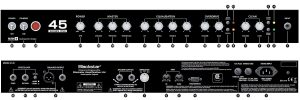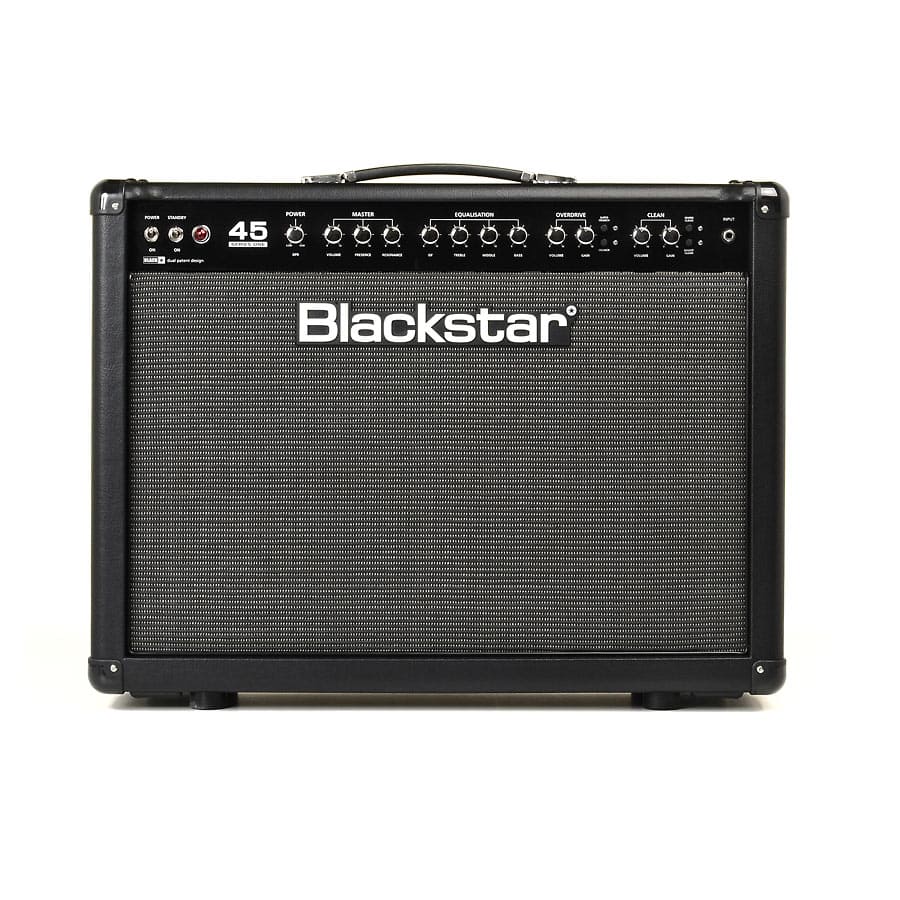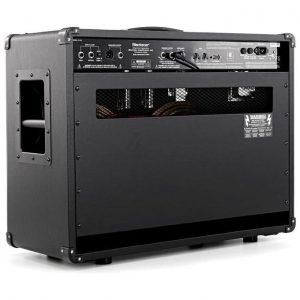How about a rip-snorting Blackstar Series One 45 Combo that you can dial down to a level to suit any stage? The Series One offers this and whole lot more. Review by Dave Petersen.
Blackstar has made its name as a maker of high-quality amps with old-school values at prices that have raised the bar in respect of what you get for your money. Their Artisan amps have become the preferred weapons of newly successful bands wanting classic tone from a modern unit, while the little HT-5 is doing good business in the rehearsal/home recording market.
Blackstar Series One 45 Combo, introduced at this year’s Frankfurt show, pushes a new design agenda – the tone quality of the older models coupled to features like increased Clean/Overdrive flexibility, footswitch control and a MIDI port.
The audio design of the 45 is mainly the work of Ian Robinson and Bruce Keir, who originally set up Blackstar, while ‘new boy’ Cliff Brown contributed to the micro-controller, MIDI and DPR features. Our initial impression is that the Series One amps are a serious shot at offering classic looks, sounds and modern smart controllability in one unit, without each treading on the others’ toes.
Pros and Cons
Table of Contents
The four-function EQ with its ISF notch-shifter will be familiar to Blackstar HT-5 users, but the three-function Master section with Volume, Presence and Resonance and the continuous 4.5-45W DPR (Dynamic Power Reduction) control are new.
The Clean/Overdrive channels are different to the classic Normal/Brilliant voices of the Artisan. But Blackstar Series One 45 Combo really bares its teeth on the rear panel, with its MIDI port and multifunction footswitch replicating the logic-driven four-button channel and voice selector on the front panel. There’s enhanced protection for the 45’s valves against real-world accidents, such as lack of a speaker connection. Courtesy of the micro-controller that also handles the DPR and power amp shutdown features.

This circuitry also provides for such options as use of the emulated Line Out with the Standby off for silent recording. While MIDI users will appreciate the possibility of incorporating the 45’s switching options into their patches, allowing you to set up individual effect and amp voice combinations.
Features of Blackstar Series One 45 Combo
Physically, the 45 has a solid elegance, with its full-width 12-knob control panel framed by the cabinet’s big edges. The designers have made an effort to save weight. Specifying ultra-light high-efficiency Celestion neodymium speakers specially ‘vintage’ voiced for the Series One range. Big and solid-looking though it is, the 45 is around 4kg lighter than some classic combos with lower power.
Blackstar’s highly-rated hardware quality is maintained with milled control knobs, big metal toggles. A robust leather carrying strap with a star emblem, and 4×12-style recessed metal grabs. The all-ply 18mm cabinet has wide radius edges finished in smooth black vynide and corner caps in heavy plastic. The rear of the cab is covered by a ported panel with a steel ventilator grille. Storage of foreign objects is obviously discouraged!

- EQ with its ISF notch-shifter
- 4.5-45W DPR control
Internally, the steel chassis is carried by four big bolts and houses four printed circuit boards. The biggest has a large heatsink for the thirsty logic board’s power supplies. The smallest is a separate carrier for the output valves with their special tracking considerations.
The preamp valve board seems to have most of the audio tasks. While the wide upright one across the rear apron carries the micro-controller and MIDI processor. As well as the DI, emulation and effect loop functions. Lessons have been learned from makers who attempt to get everything onto one board and end up with a compromised. Fragile structure in order to save a few interconnects. But it’s inevitably a long way from the tagboard-based hardwiring of the Artisans.
Sounds Blackstar Series One 45 Combo
It’s apparent from the start that the 45 is a different animal. Once the microcontroller detects that you’re connected to the input, that there are indeed speakers connected to the output. And agrees to let power into the amp.

The Strat defaults to the Bright voice of the Clean channel, and with the Gain and Volume at half. Master and DPR maxed and Presence and Resonance sensible. There’s a good level of clangy, rhythm-friendly chug with that Blackstar clarity. It can sound light on bass, but that’s no bad thing in a big mix, and it keeps the bass player on side. Anyway, select Warm on the panel and it kicks in supple bottom end without losing any of that sparkle.
Volume
Turn up the Volume and the amp cuts through at big gig level without losing the plot. Perhaps, to the bright, efficient neodymium speakers. With humbuckers the Warm voice is really too bottomy. But Bright is perfectly balanced for funky chord work and lets the middle strings do the talking. Worth pointing out, too, is the unusual lack of hum when the guitar is potted down halfway. Even a single-coil can’t make this amp buzz.
Toggle in the Overdrive Channel on Crunch and the amp’s clarity blends with some well-judged distortion that can be adjusted with the guitar pot. Or by using the Gain control around the middle mark. The EQ array comes in handy to calm some enthusiastic highs. But these also have their uses with our SG to get that Buddy Guy twang if you haven’t got a Strat, or for Super Lead/Les Paul simulations.
Super Crunch takes you into the legato solo zone, with the SG doing its best Moog impression. This is particularly successful given that it’s Blackstar’s first shot at a metal voicing. And justifies the long development that went into Series One. The clarity’s still there, though – you can’t lose the basic nature of those neo’s. But if you push the Resonance control you can make them shake the floorboards.
The DPR is a useful feature. Winding it down makes the amp sound ‘smaller’ without affecting the tone. And you can push the amp at comfortable recording levels with DPR towards minimum. But, as you might not expect, it’s still fairly loud. The lowest 4.5W setting via the 100dB-for-1W neo’s will still produce 106dB, or about 10W via standard speakers. So this is more for setting the amp to a comfortably variable gigging level than doing a live midnight recording session in your flat.
On the other hand, the Line/DI emulated output can be used with the 45 on Standby. With full preamp functions, and through our little headphone amp it sounds very like the speakers. So there’s another way round.
Verdict
Many amp makers who attempt the ancient/modern thing fall between two stools. What Series One offers is high tech in the right places. Expanding the amp’s control facilities unobtrusively while leaving the valves to do the talking. In the 45, they do so to the best possible effect and at a surprisingly reasonable price.


Leave a Reply
You must be logged in to post a comment.